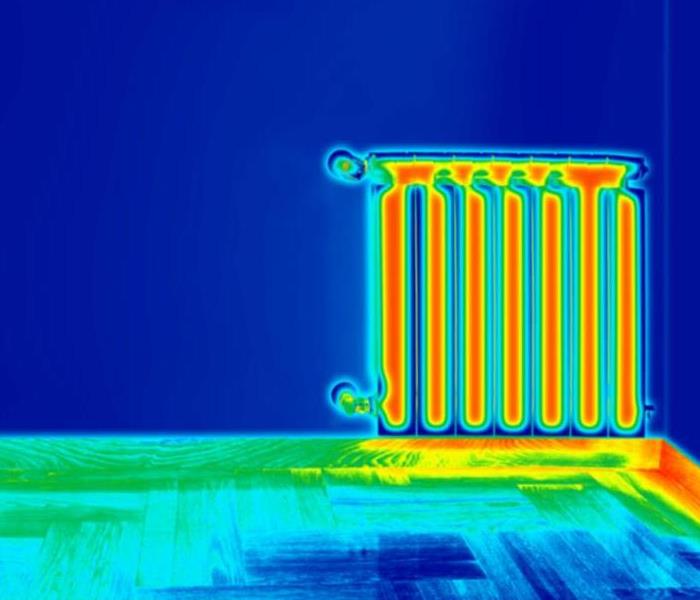Can Thermal Imagery Help Identify Water Damage in My Teaneck Home?
6/29/2020 (Permalink)
There are many advantages to using infrared technology to scope a water loss incident in your Teaneck property.
Understanding the spread and severity of water damage in your Teaneck home is one of the initial steps to restoring it. From the time that our professionals first arrive after getting notified of an active emergency, our project manager and crew chief both work with the customer to determine the extent of the damage and any pre-existing conditions that we should be aware of moving forward.
There are multiple levels of water damage in Teaneck homes and businesses that our professionals must address, this is exponentially more challenging without the appropriate knowledge of where moisture pockets exist. Surface water might be simple to detect and even treat in certain circumstances, but this is seldom the full extent of the damage. Migration often forces water into structural cavities, and exposed materials can absorb moisture as well. Identifying where this water is, and its concentration, is one of the focal points of job scoping.
How Does Thermal Imagery Work in Water Restoration?
As you might somewhat know, thermal imagery and infrared technology have become regular staples in loss restoration. This technology works by identifying variances in temperature that can indicate the presence of moisture. The entire approach hinges on a scientific truth known as thermal capacitance. This term describes the ability of specific materials or substances to store and retain heat over long periods. This ability, in terms of water restoration, means that thermal imagery can often detect fluctuations in temperature after time has passed. Using thermal imaging and infrared technology, our experienced technicians can usually identify:
- Moisture Pockets
- Dampness
- Plumbing Damage
When Is the Best Time to Use Infrared?
Despite its usefulness, there are only certain circumstances where thermal imagery is the best choice. Responding technicians can choose which techniques can best identify moisture pockets and dampness within materials and structural cavities to address the drying of your home thoroughly. There are specific advantages to choosing advanced technologies like infrared, even if this approach is not entirely without flaws. Some of the benefits of choosing thermal imagery to identify moisture pockets include:
- No destruction to the home – One of the specific benefits of choosing this approach to identify moisture pockets is its non-invasiveness. We do not need to remove portions of drywall or probe through materials to get readings.
- Aids in inspecting challenging areas – Many areas of the property can be difficult to reach with our detection equipment. However, thermal imagery can sweep this area and help our technicians to determine if a closer evaluation is necessary.
- You can cover ground more quickly – With the imagery in a handheld device that can move with the technician, infrared sweeping of the property can happen fast. We can identify moisture pockets and dampness concerns quickly in this regard.
Why Is Thermal Imagery Not Used Exclusively?
Many tools and technologies get used during the job scoping phase for area homes and businesses. While there are many distinct advantages to selecting infrared imagery of the property after a water loss, this is not exclusively the best choice in all situations. Because the approach works on identifying cooler temperature points, often generated by the presence of water, there is a potential for false positives that might temporarily slow down restoration.
What Are Other Moisture Detection Devices?
Because thermal imagery is not infallible, there are many other moisture detection tools that our SERVPRO team can use. Each of these approaches has its place in job scoping and damage evaluation for the property. Choosing among these options happens at the discretion of our crew chief and project manager walking the property and cataloging the damage. The more thorough and accurate our determination of water presence can be, the shorter and less costly restoration becomes. Beyond thermal imaging, there are several other practical approaches for identifying moisture pockets and their concentration, even beyond surface materials. Some of these include:
- Moisture sensors
- Surface detection tools
- Probing moisture meters
Water loss incidents can get out of control quickly, especially without a working knowledge of the migration of water damage and its concentration. While there are multiple approaches to discover where dampness exists beyond the surface materials, thermal imagery is still one of the most heavily used in residential and commercial applications. Give our SERVPRO of Teaneck / Englewood team call today at (201) 266-0482. We can make water losses in your home “Like it never even happened.”






 24/7 Emergency Service
24/7 Emergency Service